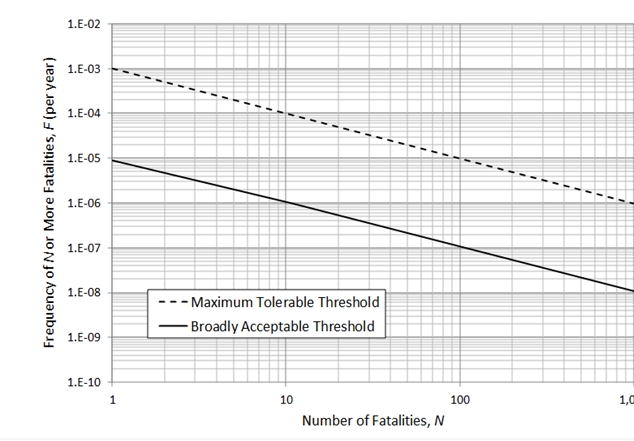Ask Our Expert Blog Series: Dan Williams
Canadian Standards Association (CSA) Z662:23 Proposed Updates: Risk Assessment
What are the main updates proposed for the CSA Z662:23 Standard pertaining to Risk Assessment?
The CSA Z662 Risk Management Task Force has developed proposed, quantitative Safety Risk and Environmental Risk acceptance guidelines for the 2023 Standard (Standard recently out for public review) as part of the non-mandatory Risk Assessment Annex (Annex B) in the CSA Z662 Standard. The proposed risk acceptance criteria are as follows:
- Guidance on safety risk (LoF x CoF ) acceptance criteria:
- Individual risk: the broadly acceptable individual risk threshold is 1 x 10-6/yr and the maximum tolerable risk threshold is 1 x 10-4/yr.
- Societal risk: the broadly acceptable and maximum tolerable thresholds are as established on an F-N curve as shown in Figure 1.

- Guidance on environmental risk acceptance criteria:
- Broadly acceptable environmental risk threshold is 2.4 x 10-2 m3/km-yr and the maximum tolerable risk threshold is 2.4 m3/km-yr (impact-adjusted release volume.)
</ul style>
What is the intent behind these changes for the industry to be aware of?
The intent behind CSA Z662 developing these proposed updates is to effectively align with other higher consequence industries and other international pipeline jurisdictions to establish industry-wide risk acceptance criteria that are standardized and widely accepted. With an aim of eliminating high consequence incidents, it is of key importance for Integrity Management teams to have a meaningful basis and target for applying effective risk mitigation programs, improvement actions and overall decision-making. These risk acceptance thresholds are expected to be a useful tool in demonstrating pipeline safety to stakeholders in the context of both pipeline risk assessments and engineering assessments.
How does Dynamic Risk support pipeline operators to address these updates?
Dynamic Risk supports the alignment of our clients’ risk modeling and risk assessments to provide for the ability to compare against risk acceptance criteria. Dynamic Risk applies the required expertise and rigor to risk modeling and risk assessment to ensure the approaches provide for effective decision-making through comparison to appropriate risk acceptance criteria.
Our software application, IRAS RiskAnalyst, provides Integrity Management teams the ability to understand and manage the various changes impacting pipeline risk using a variety of approaches with quantitative risk measures. Users can demonstrate an optimized plan through systematic testing, scenario models and cost-benefit analysis to continuously refine and improve their pipeline risk assessment program. There are many ways to calculate risk and the ability for operators to make informed and confident decisions for their risk assessment and mitigation actions is top priority.
About the Author:
Dan Williams, P.Eng.

Dan Williams is a licensed professional engineer with a Bachelor of Engineering Science (B.E.Sc.) in Materials Engineering and has over 30 years combined experience in pipe manufacturing and pipeline integrity. Dan is a Principal Consultant at Dynamic Risk where he is responsible for providing technical leadership in pipeline engineering assessment and risk management services.
This includes providing subject matter expert guidance on the development of pipeline risk models (leveraging in-line inspection, direct assessment and GIS inputs), conducting threat-based engineering assessments and evaluating and reporting on pipeline risk results as actionable risk reports that can support effective decision-making for clients in Canada and the United States.


